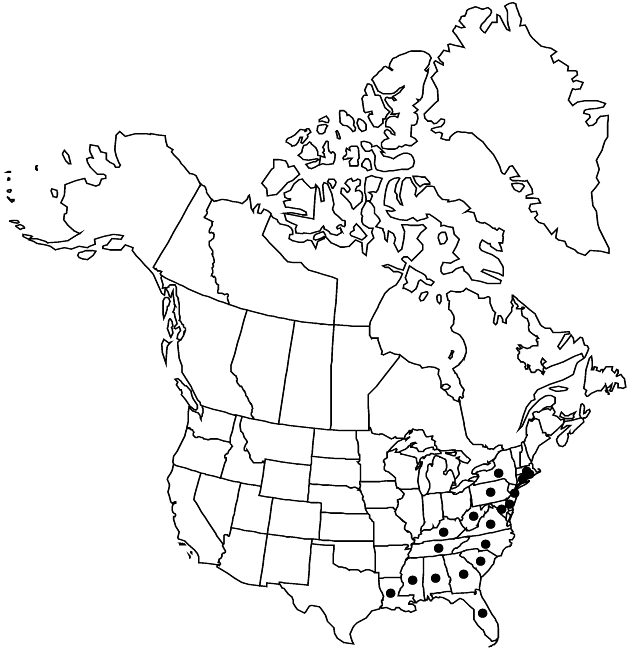Difference between revisions of "Eupatorium pilosum"
Fl. Carol., 199. 1788.
FNA>Volume Importer |
FNA>Volume Importer |
||
| Line 12: | Line 12: | ||
|name=Eupatorium rotundifolium var. saundersii | |name=Eupatorium rotundifolium var. saundersii | ||
|authority=(Porter ex Britton) Cronquist | |authority=(Porter ex Britton) Cronquist | ||
| − | }}{{Treatment/ID/Synonym | + | }} {{Treatment/ID/Synonym |
|name=Eupatorium verbenifolium | |name=Eupatorium verbenifolium | ||
|authority=Michaux | |authority=Michaux | ||
| Line 30: | Line 30: | ||
|elevation=20–100+ m | |elevation=20–100+ m | ||
|distribution=Ala.;Conn.;Del.;Fla.;Ga.;Ky.;La.;Md.;Mass.;Miss.;N.J.;N.Y.;N.C.;Pa.;R.I.;S.C.;Tenn.;Va.;W.Va. | |distribution=Ala.;Conn.;Del.;Fla.;Ga.;Ky.;La.;Md.;Mass.;Miss.;N.J.;N.Y.;N.C.;Pa.;R.I.;S.C.;Tenn.;Va.;W.Va. | ||
| − | |discussion=<p>Eupatorium pilosum has been most commonly treated as a variety of E. rotundifolium; it is distinct morphologically by its leaves, which are narrower and 3-nerved distal to bases, rather than 3-nerved from bases. Distal leaves of E. pilosum tend to differ from the proximal by being alternate with entire margins.</p> | + | |discussion=<p><i>Eupatorium pilosum</i> has been most commonly treated as a variety of <i>E. rotundifolium</i>; it is distinct morphologically by its leaves, which are narrower and 3-nerved distal to bases, rather than 3-nerved from bases. Distal leaves of <i>E. pilosum</i> tend to differ from the proximal by being alternate with entire margins.</p> |
|tables= | |tables= | ||
|references= | |references= | ||
| Line 54: | Line 54: | ||
|publication year=1788 | |publication year=1788 | ||
|special status= | |special status= | ||
| − | |source xml=https://jpend@bitbucket.org/aafc-mbb/fna-data-curation.git/src/ | + | |source xml=https://jpend@bitbucket.org/aafc-mbb/fna-data-curation.git/src/8f726806613d60c220dc4493de13607dd3150896/coarse_grained_fna_xml/V19-20-21/V21_1180.xml |
|tribe=Asteraceae tribe Eupatorieae | |tribe=Asteraceae tribe Eupatorieae | ||
|genus=Eupatorium | |genus=Eupatorium | ||
Revision as of 16:30, 18 September 2019
Perennials, 30–100+ cm. Stems (from short rhizomes) single, sparsely branched distally, densely puberulent to pilose throughout. Leaves usually opposite (distal sometimes alternate); simple, sessile or subsessile; blades ± 3-nerved (distal to bases), elliptic, lanceolate, or lance-ovate, 30–90 × 20–45 mm (lengths mostly 2–2.5 times widths), bases rounded to rounded-cuneate, margins unevenly serrate, apices acute to attenuate, faces puberulent, gland-dotted. Heads in corymbiform arrays. Phyllaries 7–10 in 2–3 series, oblong to lance-oblong, 2–7 × 1–1.5 mm, apices (sometimes whitish) acuminate to acute, mucronate, abaxial faces puberulent, gland-dotted. Florets 5; corollas 3.5–4 mm. Cypselae 3–4 mm; pappi of 30–50 bristles 4–5 mm. 2n = 20, 30, 40.
Phenology: Flowering Jul–Sep.
Habitat: Moist, low ground, margins of ponds, sandy soils, savannas, ditches
Elevation: 20–100+ m
Distribution

Ala., Conn., Del., Fla., Ga., Ky., La., Md., Mass., Miss., N.J., N.Y., N.C., Pa., R.I., S.C., Tenn., Va., W.Va.
Discussion
Eupatorium pilosum has been most commonly treated as a variety of E. rotundifolium; it is distinct morphologically by its leaves, which are narrower and 3-nerved distal to bases, rather than 3-nerved from bases. Distal leaves of E. pilosum tend to differ from the proximal by being alternate with entire margins.
Selected References
None.